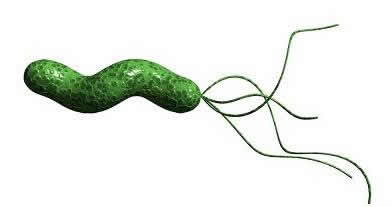H.pylori (Helicobacter pylori) is the bacteria responsible for most ulcers and many cases of stomach inflammation. H. pylori infection is most likely spread by consuming food or water contaminated with fecal matter. Approximately 50% of the world population is estimated to have detectable H. pylori in their gastrointestinal tract. Helicobacter pylori infection in humans is characterized by a marked infiltration of neutrophilic leukocytes of the gastric mucosa, and the generation of ROMs (reactive oxygen metabolites) may play a part in the development of serious chronic type B gastritis.
Astaxanthin for Helicobacter pylori Infection
 Astaxanthin acts as an antioxidant that protects against tissue damage induced by reactive oxygen metabolites (ROMs), and it may also inhibit infection through an altered immune response. Because astaxanthin can change the immune response, it is many effective at reducing Helicobacter pylori which can help prevent some types of gastric cancer and other stomach problems. Some researches have shown that potent T helper 1 (Th1) cellular immune responses contribute to Helicobacter-associated gastritis and that Th2 T lymphocytes producing interleukin 4 decrease the bacterial load of H. felis-infected mice. In a study, the researcher states that “ experimental studies, both in vivo and in vitro, have shown that astaxanthin and vitamin C are not only free radical scavengers but also show antimicrobial activity against H. pylori”. It has been shown that astaxanthin changes the immune response to Helicobacter pylori by shifting the Th1 response towards a Th2 T-cell response.
Astaxanthin acts as an antioxidant that protects against tissue damage induced by reactive oxygen metabolites (ROMs), and it may also inhibit infection through an altered immune response. Because astaxanthin can change the immune response, it is many effective at reducing Helicobacter pylori which can help prevent some types of gastric cancer and other stomach problems. Some researches have shown that potent T helper 1 (Th1) cellular immune responses contribute to Helicobacter-associated gastritis and that Th2 T lymphocytes producing interleukin 4 decrease the bacterial load of H. felis-infected mice. In a study, the researcher states that “ experimental studies, both in vivo and in vitro, have shown that astaxanthin and vitamin C are not only free radical scavengers but also show antimicrobial activity against H. pylori”. It has been shown that astaxanthin changes the immune response to Helicobacter pylori by shifting the Th1 response towards a Th2 T-cell response.
In a study published in Dec 1999 edition of Immunology Letters; researchers studiedthe effect of astaxanthin on inflammation in mice infected with Helicobacter pylori. They discovered that mice consuming a cell extract containing astaxanthin experienced reduces in gastric inflammation. A high intake of carotenoids and vitamin C has been proposed to avoid development of gastric malignancies. In a study, performed at the University of Lund in Sweden, mice infected with Helicobacter pylori were given daily therapies for 10 days of either algal meal rich in astaxanthin of different potencies (10, 50 and 100 mg/kg body weight), 400 mg/kg vitamin C. After one and ten days post-treatment, both the vitamin C and astaxanthin groups demonstrated significantly lower H. pylori colonization levels and lower inflammation scores than controls, with astaxanthin showing a dose-dependent response. In a clinical study conducted in 1999, involved 10 H. pylori positive people (non-ulcer) with typical dyspeptic symptoms such as heartburn and gastric pain, were each treated with 40 mg daily dose of astaxanthin for 21 days. The gastric pain, heartburn and total clinical symptoms results demonstrated a important drop of 66%, 78% and 52% drop respectively. In this study, various doses of astaxanthin (16 mg or 40 mg) were compared to placebo in a group of 132 participant with dyspepsia over a 4-week period. The higher dosage of astaxanthin significantly decreased the symptoms of heartburn and this effect was most pronounced in the people found to be infected with Helicobacter pylori.
Leave a Reply